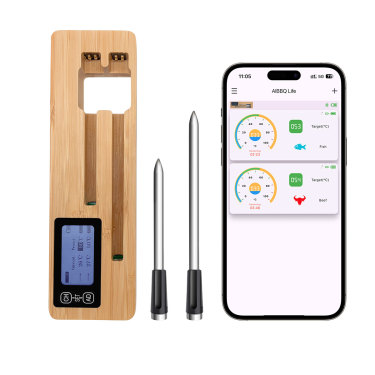
# Digital Meat Thermometer: The Essential Tool for Perfect Cooking
## Why Every Kitchen Needs a Digital Meat Thermometer
Cooking meat to perfection is both an art and a science. Whether you’re grilling steaks, roasting a turkey, or preparing pork chops, achieving the ideal internal temperature is crucial for both safety and taste. This is where a digital meat thermometer becomes indispensable.
Unlike traditional analog thermometers, digital versions provide precise, instant readings that take the guesswork out of cooking. No more cutting into your meat to check doneness or serving undercooked poultry – with a digital thermometer, you’ll know exactly when your food reaches its perfect temperature.
## Key Features to Look For
When shopping for a digital meat thermometer, consider these important features:
### 1. Fast and Accurate Readings
Look for models that provide temperature readings within 2-3 seconds with an accuracy of ±1°F (±0.5°C). This ensures you get reliable results every time.
### 2. Temperature Range
A good digital thermometer should cover a wide range, typically from -58°F to 572°F (-50°C to 300°C), suitable for everything from frozen meat to high-heat grilling.
### 3. Probe Design
The probe should be thin enough to insert without damaging the meat yet sturdy enough to withstand regular use. Stainless steel probes are most durable.
### 4. Easy-to-Read Display
Backlit LCD screens make reading temperatures easy, even in low-light conditions like outdoor grilling at night.
## How to Use Your Digital Meat Thermometer
Using your thermometer properly ensures accurate results:
1. Insert the probe into the thickest part of the meat, avoiding bones and fat.
2. For thin cuts, insert the probe sideways to get a proper reading.
3. Wait for the temperature to stabilize (usually just a few seconds with digital models).
4. Compare your reading to FDA-recommended safe internal temperatures.
5. Clean the probe thoroughly after each use.
## Recommended Safe Cooking Temperatures
Keyword: digital meat thermometer
Here are the USDA-recommended minimum internal temperatures for common meats:
– Poultry (chicken, turkey): 165°F (74°C)
– Ground meats: 160°F (71°C)
– Pork: 145°F (63°C) with 3-minute rest
– Beef, veal, lamb steaks and roasts: 145°F (63°C) with 3-minute rest
– Fish: 145°F (63°C)
## Maintenance and Care Tips
To keep your digital meat thermometer functioning properly:
• Always clean the probe immediately after use with warm, soapy water
• Avoid submerging the display unit in water unless it’s specifically waterproof
• Store the thermometer in a protective case when not in use
• Replace batteries as needed to maintain accuracy
• Calibrate periodically according to manufacturer instructions
## The Bottom Line
A digital meat thermometer is one of the most valuable tools in any kitchen. It takes the stress out of cooking meat, ensures food safety, and helps you achieve perfectly cooked results every time. Whether you’re a professional chef or a home cook, investing in a quality digital thermometer will elevate your culinary skills and give you confidence in the kitchen.